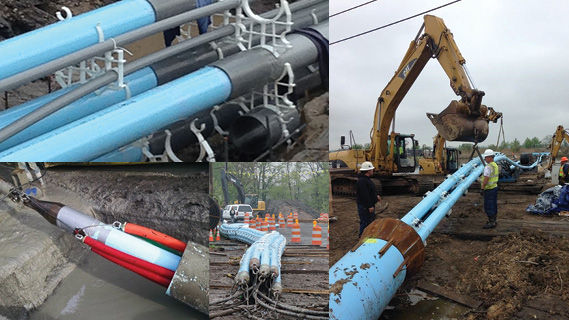Benefits Of Utilizing Directional Drilling For Underground Wire Installation
- Grid Tech
- Jun 8, 2023
- 3 min read
Are you tired of grappling with the complexities and limitations of traditional methods for underground wire installation? Do you crave a solution that offers efficiency, precision, and cost-effectiveness? Look no further than the game-changing technique of directional drilling.
When it comes to underground wire installation, conventional approaches often present a slew of challenges. The arduous and time-consuming process of trenching not only disrupts the landscape but also poses a significant risk of damaging existing infrastructure. These drawbacks, coupled with the high costs associated with excavation and restoration, have long hindered progress in this field.
However, directional drilling emerges as a revolutionary alternative, bringing a myriad of benefits to the table. By harnessing this innovative technology, you can bid farewell to the days of disruptive trenches and welcome a new era of efficiency and precision.

What are Boring Services?
Underground boring services, commonly known as horizontal directional drilling (HDD), refer to the technique of subterranean drilling that eliminates the need for trenches for underground wire installation
HDD allows for the creation of deep boreholes, enabling the installation of pipes and utilities without the reliance on ground-level trenches. It serves as an ideal alternative when trenching and excavation are not feasible options. This versatile drilling method is applicable in various soil conditions.
With directional drilling, you can say goodbye to the hassle of extensive excavation and restoration. The small entry and exit points reduce the need for disruptive trenches, resulting in less environmental impact and reduced costs. Plus, this innovative method enables you to install wires in challenging terrains, such as rocky areas or densely populated urban landscapes, where traditional techniques fall short.
Harnessing the power of directional drilling for underground wire installation unlocks a multitude of benefits. From increased efficiency and precision to reduced costs and environmental impact, this technique revolutionizes the way we approach underground wiring projects. Step into the future of wire installation and experience the transformative advantages of directional drilling.
To ensure efficient execution, it is essential to evaluate soil types and identify potential obstacles in advance. Additionally, the engineer or worker must determine the optimal depth and angle for drilling the borehole. The process begins by drilling an initial aperture along the designated path. As drilling progresses, the machine gradually enlarges the hole to the required diameter while delving deeper into the ground.
Once the excavation is complete, the designated utility, such as an electrical wire or pipeline, is meticulously installed into the ground using a unique pull-out mechanism connected to the drilling equipment. The borehole is then backfilled, restoring the drilling area to its original state.

What Are the Advantages?
One notable benefit of utilizing HDD for pipeline and utility installation is its significantly reduced environmental impact compared to traditional open-cut techniques. Excavating trenches or holes through open-cut methods can harm surrounding vegetation, alter the landscape, and result in soil erosion. It may also disrupt water bodies and habitats, posing a threat to the environment.
In contrast, horizontal directional drilling minimizes surface disruption during underground wire installation. By employing a guided drilling machine, this method involves drilling a small pilot hole from the entry site to the exit location. The underground path of the drill head can be adjusted in real-time to avoid obstacles, such as trees.
When it comes to pipeline construction, HDD surpasses open-cut methods in terms of speed, efficiency, and labor effectiveness. Utilizing underground boring services for multiple pipelines in a single borehole eliminates the need for additional excavation sites. The procedure also reduces noise, dust, and debris pollution.
Moreover, HDD enables underground wire installation in challenging terrains where traditional open-cut techniques are impractical, such as rocky soil, wetlands, and urban areas. It also reduces the need for additional maintenance and rehabilitation efforts, saving valuable time and resources.
In comparison to traditional open-cut pipe installation techniques, underground boring services offer cost advantages. The reduced excavation and material requirements translate into lower labor and equipment expenses. Additionally, the flexibility of Horizontal Directional Drilling allows for wire installation in hard-to-reach areas, eliminating the need for costly maintenance and rehabilitation endeavors.
Furthermore, HDD mitigates the risks of underground wire installation leaks and damages, which can be expensive to repair and pose hazards to public safety and the environment. The method also demands less frequent maintenance, resulting in long-term cost savings.

Final thought
When compared to conventional excavation processes, underground boring services offer affordability, minimal disruption, and expedited installation. Their adaptability and environmental friendliness have made them a popular choice for numerous construction projects.
If you are considering the utilization of underground boring services for your next venture, it is crucial to engage a reputable and knowledgeable contractor. They can provide the expertise and technology necessary for successful underground wire installation. By harnessing the advantages of HDD, businesses can enhance productivity, reduce costs, improve safety, and minimize environmental impact. Therefore, HDD should be considered a viable option for pipeline installation projects.


Comments